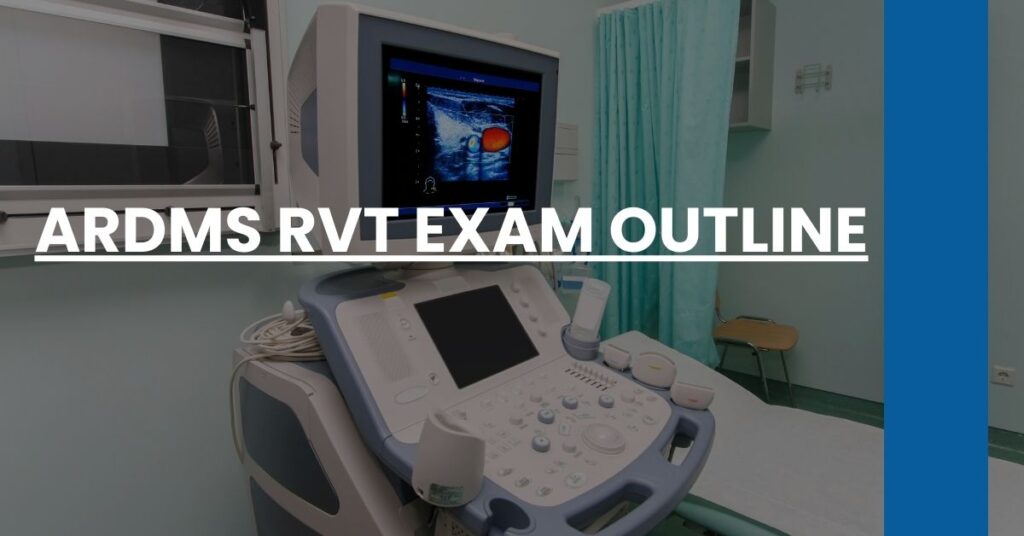The ARDMS RVT Exam Outline details the key areas assessed, including cerebrovascular, venous, arterial, and abdominal vascular testing. It also covers physiological testing and basic patient care.
In this article, you’ll explore:
- Core exam topics
- Eligibility requirements
- Study and preparation tips
Learn how to navigate each section and maximize your chances of exam success.
Overview of the ARDMS RVT Exam
The ARDMS RVT (Registered Vascular Technologist) Exam is a credentialing examination designed to certify the proficiency of sonographers specializing in vascular technology. This certification is fundamental for professionals since it validates their skills in vascular sonography, enhancing their credibility and career opportunities.
Importance of RVT Certification
As cardiovascular diseases remain prevalent, expertise in vascular technology is increasingly important. The RVT certification is highly valued in the medical community. It ensures that technologists possess the necessary knowledge and skills to provide quality care in the diagnosis and treatment of vascular diseases. The exam encompasses various competencies essential for accurate vascular diagnostics, contributing significantly towards ensuring patient safety and high-quality care.
Eligibility Requirements
To be eligible for the ARDMS RVT Exam, candidates must meet specific educational and clinical criteria. This ensures that only qualified individuals undertake the exam, maintaining the high standards of the profession.
Educational Background
Formal Education Program: Candidates must complete a formal education program in diagnostic medical sonography or vascular technology. This program should be accredited by the Commission on Accreditation of Allied Health Education Programs (CAAHEP) or have equivalent credentials.
Clinical Experience Requirements
Recent Graduates: For recent graduates of an accredited program, candidates must complete a specific number of clinical hours under supervision during their training.
Healthcare Professionals: Candidates with a healthcare-related degree and additional vascular-specific coursework need proof of hands-on clinical experience. This often ranges from 12 to 24 months.
ARDMS Prerequisites
All candidates must adhere to ARDMS prerequisites:
- Provide Documentation: Validating educational background and clinical experience through appropriate documentation.
- Professional Recommendations: Including letters from professionals who can attest to the candidate’s competency.
Alternative Pathways
Substantial Professional Experience: There are alternative pathways for those who may not fit the traditional educational routes but possess substantial professional experience and training in vascular technology.
Examination Content Outline
The ARDMS RVT Exam covers a broad range of topics to ensure a comprehensive assessment of a candidate’s knowledge and proficiency in vascular technology.
Key Exam Domains
Cerebrovascular Testing: Understanding of extracranial and intracranial anatomy and pathology evaluating cerebrovascular conditions, and interpreting findings from duplex ultrasound and other cerebrovascular studies.
Venous Testing: Knowledge of venous anatomy and physiology, principles of venous hemodynamics, and techniques for diagnosing venous diseases such as deep vein thrombosis (DVT) and chronic venous insufficiency.
Arterial Testing: Proficiency in peripheral arterial testing, including ankle-brachial index (ABI) calculations, segmental pressure measurements, and interpreting waveform analysis to diagnose peripheral arterial disease.
Additional Exam Domains
Abdominal and Visceral Vascular Testing: Understanding of abdominal vascular systems, methodologies for evaluating blood flow in major abdominal vessels (e.g., aorta, renal arteries), and recognizing conditions like aneurysms and stenosis.
Physiological Testing: Expertise in plethysmography, stress testing, and other non-imaging techniques that assess vascular function and hemodynamics.
Basic Patient Care: Knowledge of patient interaction, preparation, safety protocols, and ethics in vascular sonography.
Study and Preparation Tips
Preparing for the ARDMS RVT Exam requires a strategic approach. It ensures a thorough understanding of the material and confident application of practical skills.
Strategies for Success
Invest in Quality Study Guides: Utilize ARDMS-endorsed books and guides which offer a comprehensive review of exam content. “Vascular Technology: An Illustrated Review” is highly recommended.
Practice Tests: Take regular practice exams and quizzes to assess your knowledge base and identify areas of improvement. ARDMS offers practice questions that mirror exam content and format.
Develop a Study Plan: Create a structured study schedule. Focus on weaker areas while reinforcing stronger competencies.
Additional Preparation Methods
Join Study Groups: Connect with peers preparing for the same exam. Group study can provide support, knowledge exchange, and collective problem-solving.
Online Courses and Webinars: Enroll in relevant online courses offered by the Society for Vascular Ultrasound (SVU). These offer in-depth modules on vascular technology.
Hands-on Practice: Gain as much clinical experience as possible. Practical exposure to diagnostic procedures and equipment improves comfort and proficiency.
Stay Updated: Read recent journal articles and research in vascular technology. This helps keep abreast of the latest advancements and updates in the field.
Exam Format and Structure
The ARDMS RVT Exam is structured to assess the candidate’s knowledge and practical skills comprehensively.
Structure and Content of the Exam
Number of Questions: The exam typically includes 170 multiple-choice questions. It encompasses both scored and unscored (pilot) questions.
Time Allocation: Candidates have about 3.5 hours to complete the exam. This is adequate for thoroughly reading and answering all questions, including time for review.
Types of Questions: The exam features different types of questions:
- Standard Multiple-choice: One correct answer among multiple options.
- Case Studies: Scenarios requiring the application of knowledge to clinical situations, often supported by images or diagrams.
- Advanced Item Types (AITs): Some questions require interaction with images, such as identifying anatomical structures or pathology on ultrasound images.
Testing Environment
The exam is administered at Pearson VUE test centers. These centers provide a standardized and secure testing environment. Understanding the structure and format can help you manage your time effectively and approach the exam with confidence.
Conclusion
The ARDMS RVT Exam is a pivotal step in validating your expertise in vascular technology. Understanding the exam’s structure, content, and preparation strategies significantly enhances your confidence and performance. Utilize the outlined resources and tips to maximize your chances of success. By achieving ARDMS RVT certification, you affirm your commitment to high standards of patient care and advanced diagnostic proficiency in vascular sonography.

